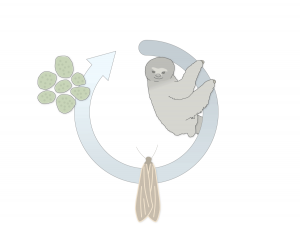The Three-Toed Sloth has one of the most intricately fascinating and self-sustaining ecosystems seen throughout the animal kingdom. Until recently Sloths were not extensively researched because of their lackadaisical lifestyle and therefore time-consuming zoological research. Yet after 35 years of scientific observation dedicated to the three-toed sloth, it is now becoming clear that the mammal is literally a walking ecosystem of biological mutualism.
Three-toed sloths are native to Central and Southern America as they reside in the treetops of highly predatory jungles. Because of the sloths slow-paced lifestyle and long armed/toed anatomical structures, they have adjusted to a life high up in the chocolate-producing cacao trees to avoid animals such as coyotes, jaguars, and aerial predators such as the eagle. For 35 years scientists have discovered that the sloth has a strange weekly ritual of leaving their treetop homes, descending to the ground, digging a hole, defecating inside of it, covering it with leaves, and then, if it has not yet been eaten, slowly climbing up to its home among the canopies. Zoologists have recently concluded that half of the sloth deaths that occur are when they are exposed on the ground. Then the age old question is, why do three-toed sloths perform this oddly species-specific task of risking their lives on a weekly basis?

The answer is within their fur. The three-toed sloths harbor an extraordinary ecosystem among their fur consisting of a three-way mutualistic relationship between the sloth itself, hundreds of moths that live within the thick fleece of a single sloth, and a species of algae that grow in the grooved hairs of the sloth. At first the algae and moths were thought to give the sloth a protective camouflage while vulnerable on the ground, yet it has been recently understood that there is a much more complex networking at play.

The sloth’s slow-paced movements make it ideal for the moths to live within the sloth’s fur without any trouble . It provides a mating site for the moths, a prospective source of hatching their larvae safely, and increases the amount of nitrogen in the sloth-fur environment, allowing the algae to thrive. When the sloth makes its weekly trek down the tree to deficate, the pregnant moths take this opportunity to lay their eggs within the feces. The future moths then fly up the canopy to find other mates hiding within other sloths. Moths increase the amount of nitrogen, allowing algae to thrive and therefore creates a food source for the sloth among its own body. Sloths cannot live solely off of the leaves of the trees in which they live, yet if it can conserve as much energy as possible by sleeping and moving at a snail-like pace, it can survive off of the leaves and algae which are always within reach. The three-toed sloth may seem as if it lives one of the most boring lives possible, yet it harbors an intricate relationship of biological mutualism. 